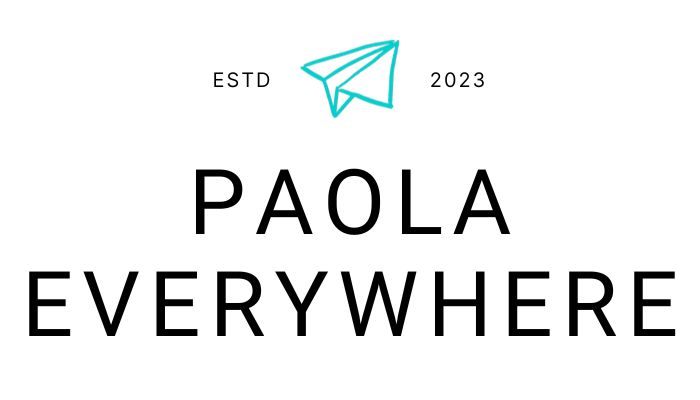I visited Gorizia and Nova Gorica intrigued by the idea of a city divided between two countries, Italy and Slovenia. Once there, I was surprised by their small-town feel rather than a big-city atmosphere. Both are compact and easy to explore on foot, crossing from one to the other almost without realising it, as if the border had never existed. Named in 2025 as the first cross-border European Capital of Culture, the twin cities have turned their history of division into a shared narrative of art and culture, which you can discover throughout this guide.
Table of Contents
Gorizia: From Hybrid Identity to Border City
At the beginning of the 20th century, Gorizia was a truly cosmopolitan place, where Italians and Slovenes lived side by side. Unlike in Trieste, these weren’t separate communities in distinct neighbourhoods, but a daily mix of languages, traditions and cultures. Gorizia’s identity was rooted in this hybrid character, where diversity was simply the norm.
After the First World War, the city passed from the Austro-Hungarian Empire to Italy. The change was dramatic and reshaped the urban landscape with new streets, monuments and even a new toponymy. For example, the historic Travnik square was renamed Piazza della Vittoria.
Alongside these changes came a forced Italianisation policy. Slovene was banned from schools, speaking the language in public was forbidden, and the Trgowski Dom, the cultural hub of the Slovene community, was set on fire in 1927.
Discrimination fuelled tensions that exploded in the power vacuum after 8 September 1943. In those months, the Foibe massacres took place, targeting not only declared fascists but also civilians, often victims of personal revenge. A once hybrid, multicultural land became scarred by hatred, even before political borders divided it.
The definitive fracture occurred on 10 February 1947, when the Paris Peace Treaty drew a line splitting Gorizia in two: Italy on one side, and Yugoslavia on the other. That line tore apart families, fields and livelihoods, turning Gorizia into a city without a hinterland.
On the other side, Nova Gorica was built from scratch as a socialist showcase, with wide boulevards and modernist buildings inspired by Le Corbusier. For more than sixty years, the two towns lived apart, separated by an impenetrable border, surviving through smuggling, mistrust and mutual curiosity.
Gorizia and Nova Gorica: From Division to a Cross-Border European Capital of Culture
Today, Gorizia and Nova Gorica are no longer divided cities, but a living example of rebirth and cooperation. In 2025, they were jointly named European Capital of Culture, the first cross-border title ever awarded. It’s a recognition that celebrates their ability to turn a historic wound into an opportunity for dialogue and connection.
The memory of that past has not been erased, but preserved in the museums that tell the story of everyday life along the border. Visiting both cities helps you understand what it meant to live in a place with a patrolled State border that was a simple white line painted on the asphalt. Just a line, but powerful enough to divide families, friends and entire communities.
During our trip, we explored several museums and heritage spaces, and it was a truly eye-opening experience. We listened to testimonies, looked at photographs and discovered installations that made the stories of those who lived through those years feel tangible.
For me, it was a way to grasp the contradictions of the 20th century better, while for my son, born as a citizen of the European Union, it was the discovery of a world far removed from his own; one where borders were not abstract concepts, but physical barriers shaping people’s daily lives.
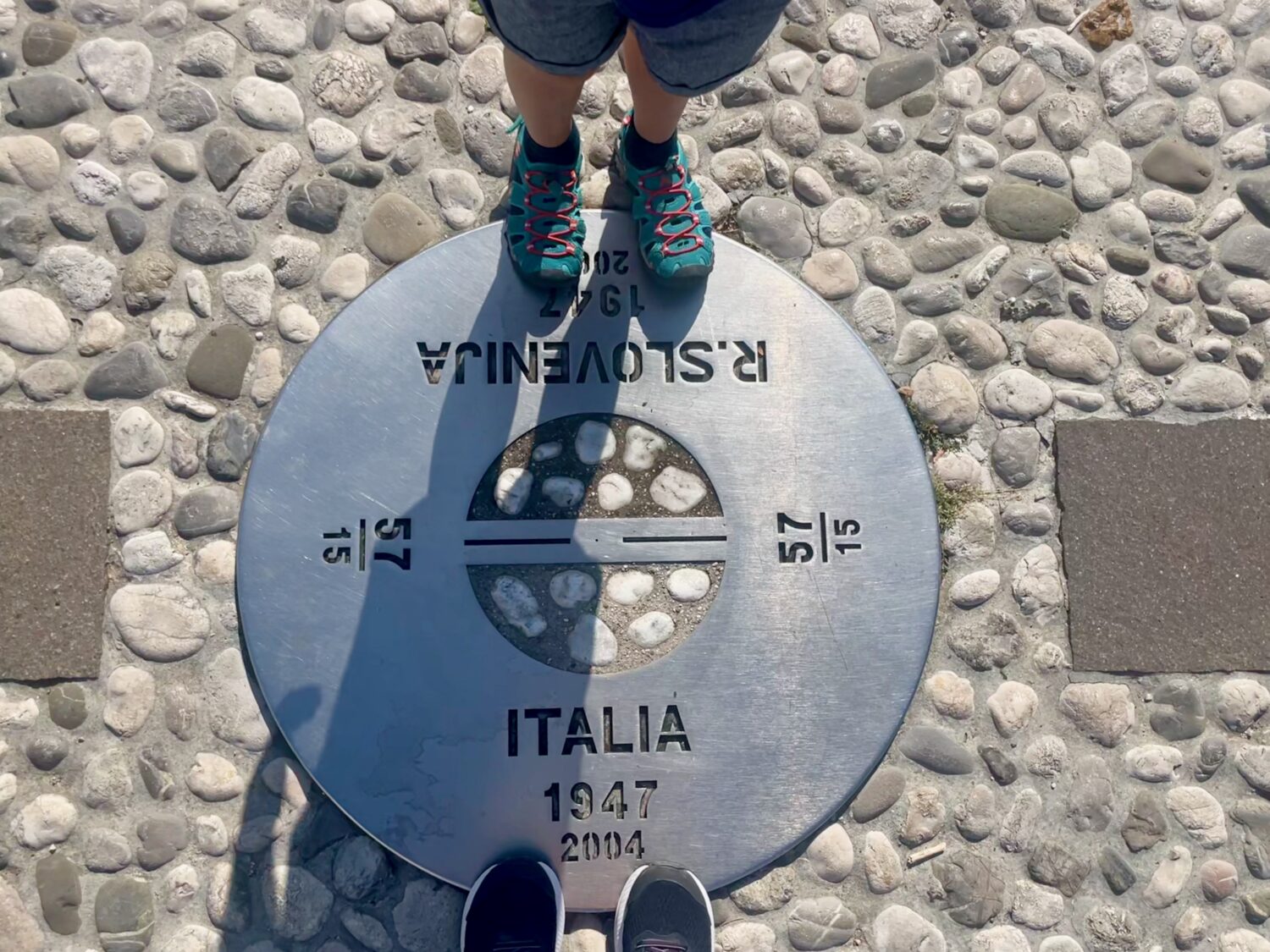
Piazza Transalpina/Trg Evrope: From Border Line to Bridge Between Italy and Slovenia
The symbolic heart of the cross-border identity of Gorizia and Nova Gorica is Piazza Transalpina in Italy and Trg Evrope in Slovenia. It’s one big square, half in Slovenia and half in Italy, with two different names.
Once, the line dividing Italy and Yugoslavia ran straight through here. Today, you can walk freely from one side to the other, with one foot in Italy and the other in Slovenia.
At the centre of the square lies a mosaic created in 2004 to mark Slovenia’s entry into the European Union. Overlooking the square is the historic Transalpina railway station, inaugurated in 1906 as a link between Gorizia and Central Europe. Inside, a permanent exhibition retraces the history of the state border from 1945 to 2004, with photographs, maps and documents.
Just a few steps away, in another building of the old station, the EPIC (European Platform for the Interpretation of the 20th Century) exhibition is taking shape. Funded by the European Union, this new museum will explore life along the border between Italy and Yugoslavia. When we visited, it was still under construction, but the project promises multimedia installations, personal testimonies and even a café.
Today, Piazza Transalpina/Trg Evrope is more than just an urban space: it is a place of meeting and memory, a bridge that reunites two cities once divided for over sixty years. We had fun hopping back and forth across the former border, while my son kept asking me, curious, which side was Italy and which was Slovenia.
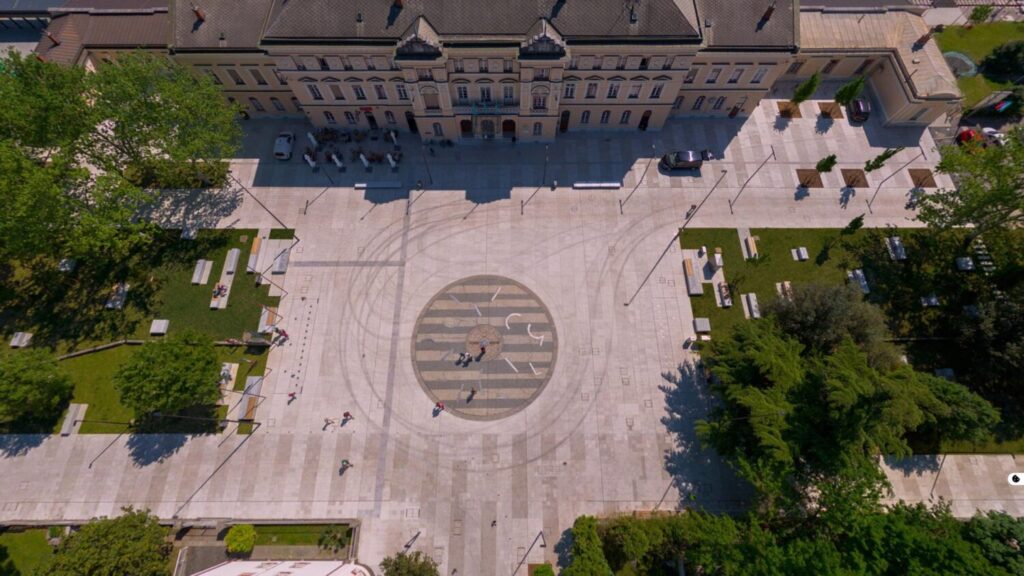
State Border Between Italy and Slovenia: Exhibition at Nova Gorica Railway Station
Inside the Transalpina station of Nova Gorica, the oldest building in the Slovenian city, you can visit a free exhibition dedicated to the State Border in the Goriška Region. The exhibits, featuring historical objects and documents, are in a former waiting room. In the adjacent corridor, you can find additional explanatory panels.
Despite its simplicity, I found it fascinating to see how the story of the border is closely tied to the history of the Transalpina railway. The line was inaugurated in 1906 in the presence of Archduke Franz Ferdinand and built as part of the grand Habsburg project to connect Vienna with the port of Trieste. The Transalpina soon became one of the most modern and strategic infrastructures of Central Europe.
After the First World War and the Treaty of Rapallo, the railway passed under Italian control. However, it was the Paris Peace Treaty of 1947 that truly changed its fate, dividing the territory between Italy and Yugoslavia and turning the line into a peripheral route, cut in two by an impenetrable border.
The museum explains how, despite the political division, the railway maintained a vital role. In the 1970s, the first steam tourist trains were introduced, and since 1986, Slovenian agencies have been organising regular seasonal heritage trips. Today, passenger trains connect Jesenice, Nova Gorica and Sežana, serving both commuters and visitors, as part of a more sustainable approach to mobility.
Muzej Državna Meja na Goriškem – Museum Collection Kolodvor
State Border in the Goriška Region
Transalpina railway station, Trg Evrope
Železniška Postaja, Kolodvorska pot 8, 5000 Nova Gorica, Slovenia
Lasciapassare / Prepustnica Museum in Gorizia: Memories of a Divided City
The Lasciapassare / Prepustnica Museum, housed in the former customs building at the Rafut border crossing, is one of the most moving places to visit in Gorizia. Admission is free and, rather than a traditional museum, it offers a multimedia journey through life along the border between 1947 and 2004.
What struck me most were the videos with first-hand accounts from people who lived through the division: families torn apart, cowsheds in Italy and barns in Yugoslavia separated by nothing more than a white line painted on the ground, and the need for a special permit (lasciapassare in Italian, prepustnica in Slovenian) to cross just a few metres while carrying only small amounts of goods. The custodians made our visit even more engaging with their explanations and anecdotes.
The exhibition centres on two installations: White Line, an immersive screen recreating the moment the border was drawn, and Fragments of Memory, an interactive table collecting personal stories.
The testimonies are powerful and authentic. Some remember having to abandon everything to decide which side to live on; others speak of constant border patrols, active day and night. Over time, relations between soldiers became friendlier, with small exchanges taking place: Italians would bring goods scarce in Yugoslavia, while Slovenians would buy meat and honey in Italy. There are also references to the Foibe massacres, arrests and deportations of 1945, when Gorizia was under Yugoslav administration for 42 days.
Visiting the Lasciapassare / Prepustnica Museum is an emotional, sensory experience. More than learning official history, you step into the everyday life of people who lived for decades suspended between two worlds.
Museo del Lasciapassare / Prepustnica
Via del Rafut, 51, 34170 Gorizia, Italy
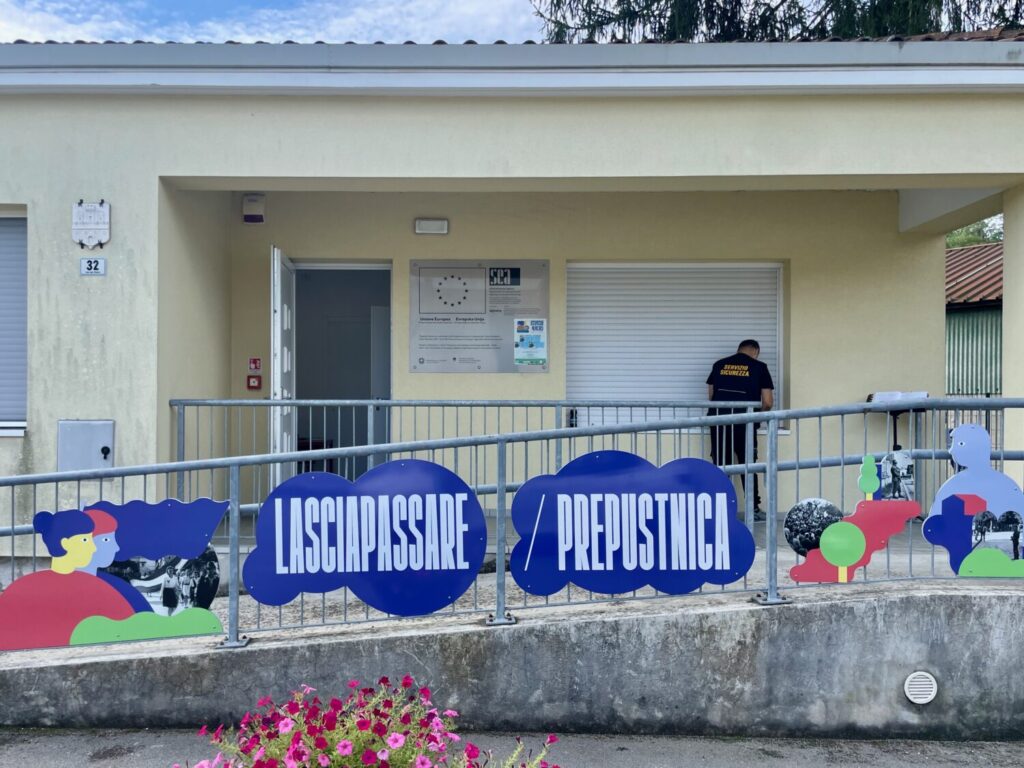
Museum on the Border in Nova Gorica: Discovering Life Between Italy and Slovenia
Just a few steps from the Lasciapassare / Prepustnica Museum in Gorizia, and on the other side of the former border, lies the Museum on the Border in Nova Gorica. Often referred to as the “smuggling museum”, the permanent exhibition Na šverc! Smuggling in the Gorizia area after the Second World War takes place in the former customs offices of the secondary Pristava crossing.
The exhibition shows how the border, besides dividing two political and economic worlds, gave rise to a daily and almost natural practice: smuggling, or šverc in Slovenian. The word originates from the German word schwarz (black) and refers to the black-market trade of essential goods or prohibited items.
In the years immediately after the war, smuggling helped families make up for shortages: Italians would cross into Yugoslavia to buy meat, honey, grappa, cigarettes and even rum imported from Cuba, while Yugoslavians crossed the border for jeans, fizzy drinks, medicines, tiles and censored literature. The most coveted, and most often seized, item, however, was coffee.
The museum illustrates this reality with photographs, original objects and personal accounts, showing the many tricks people used to hide goods: sewn into linings, tucked under clothing, or concealed in bicycles and cars. By the 1960s, with Yugoslavia’s rising purchasing power, šverc turned into genuine shopping tourism across the border. A habit that, in some ways, still exists today, such as Italians filling up their cars in Slovenia, where petrol is cheaper.
Muzejska zbirka Pristava – Museum Collection Pristava
Museum on the Border
Kostanjeviška cesta 32, 5000 Nova Gorica, Slovenia
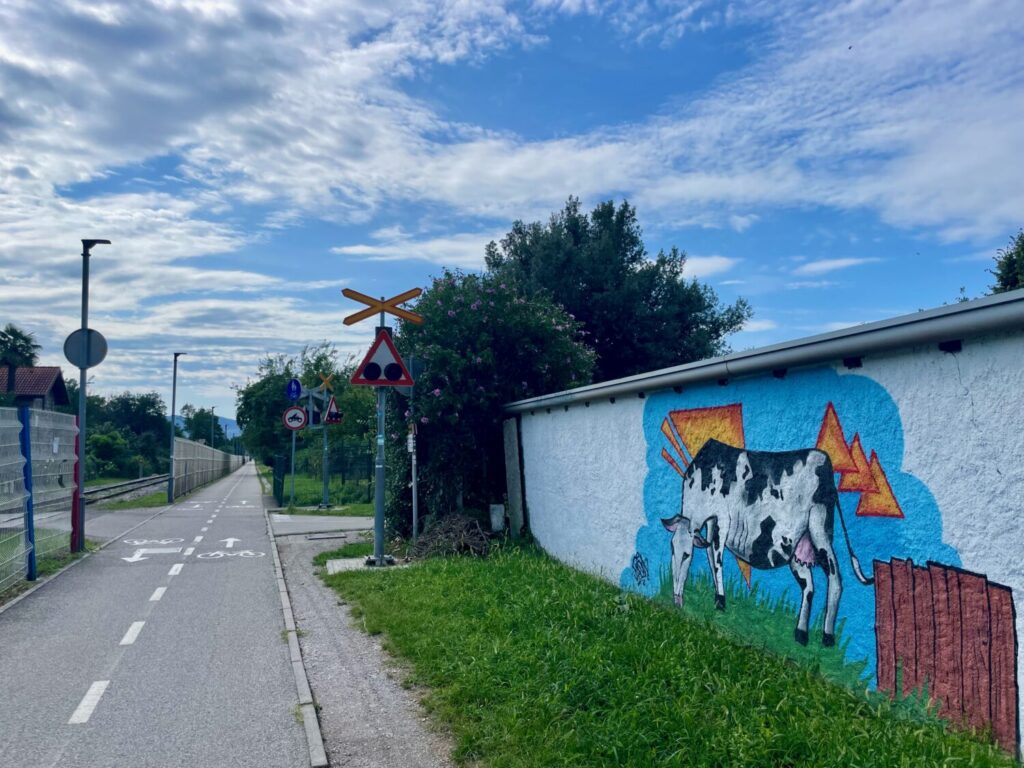
Historic Palaces and Museums: Exploring the Cultural Heritage of Gorizia and Nova Gorica
When I visited Gorizia and Nova Gorica with my son, we wanted to know their border history. Yet, what we discovered was a rich architectural and artistic heritage that tells the centuries-long story of cultural encounters.
In Gorizia and Nova Gorica, you’ll find medieval castles and fortified villages, the baroque and rococo elegance of aristocratic palaces, as well as Jewish and Catholic religious sites, and reminders of the twentieth century.
On the Italian side, in particular, every building reflects the many identities that have shaped this borderland: aristocratic families, Jewish communities, religious orders, as well as Austrian and Italian administrators. The result is a mosaic of styles and stories that coexist within the same territory.
Exploring Gorizia Castle, with its medieval walls, or stepping into the refined Palazzo Coronini Cronberg, complete with original furnishings and an English-style park, feels like entering another era. The eighteenth-century synagogue, the Kostanjevica Monastery with the Bourbon crypt, and the nearby Kromberk Castle, now home to the Goriški Muzej in Slovenia, further enrich an itinerary that blends art, history and memory.
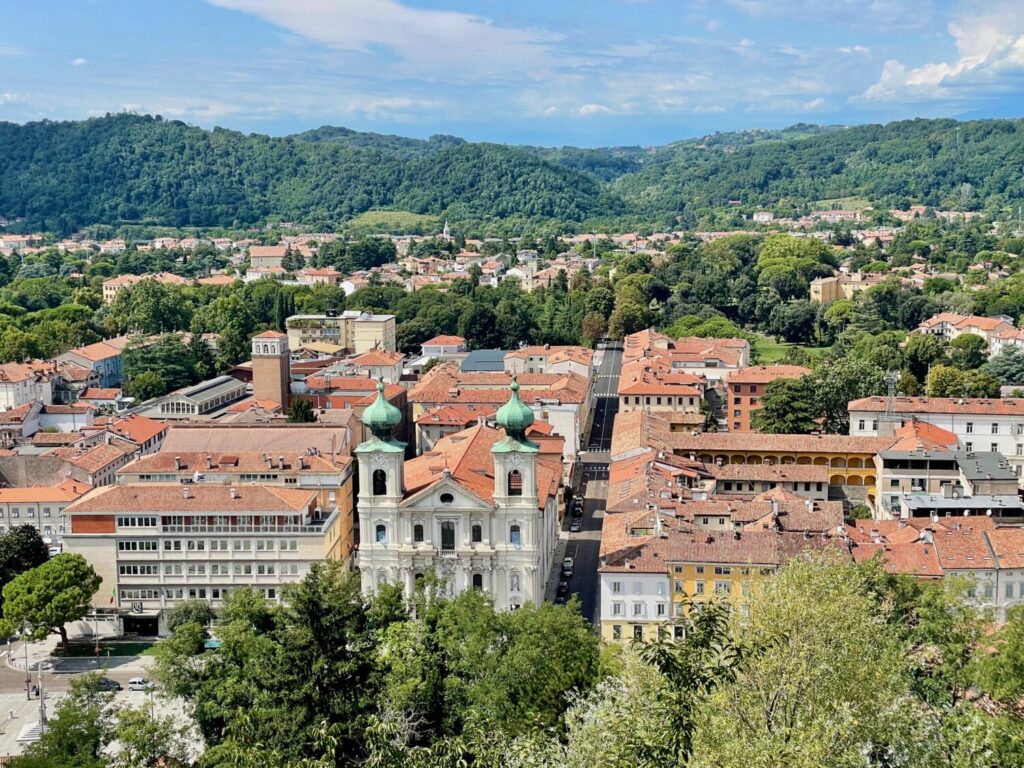
Gorizia Castle and Provincial Museums: A Journey Into the Medieval Past
The city’s most recognisable landmark is Gorizia Castle. Perched on a hilltop, it overlooks the entire area and offers spectacular views that stretch as far as Nova Gorica. Its origins date back to the 11th century, but over time, it underwent several alterations, with the addition of bastions and towers.
Throughout the centuries, the castle served different purposes: it was the residence of the Counts of Gorizia, an administrative centre, a barracks and even a prison. During the First World War, it was heavily bombed and left in ruins. Reconstruction began in the 1930s, giving the castle its medieval appearance, which still defines it today.
We thoroughly enjoyed wandering through the quiet Borgo Castello and taking in the stunning view from above. Inside, the museum features rooms furnished with period furniture, as well as collections of weapons and artefacts that illustrate both noble and popular life over the centuries. These exhibitions form part of the Provincial Museums of Gorizia.
Adding to the charm is the legend of the White Lady, Dama Bianca in Italian, the ghost of a noblewoman who, according to tradition, still appears at night within the castle walls.
Gorizia Castle
Borgo Castello, 36, 34170 Gorizia, Italy
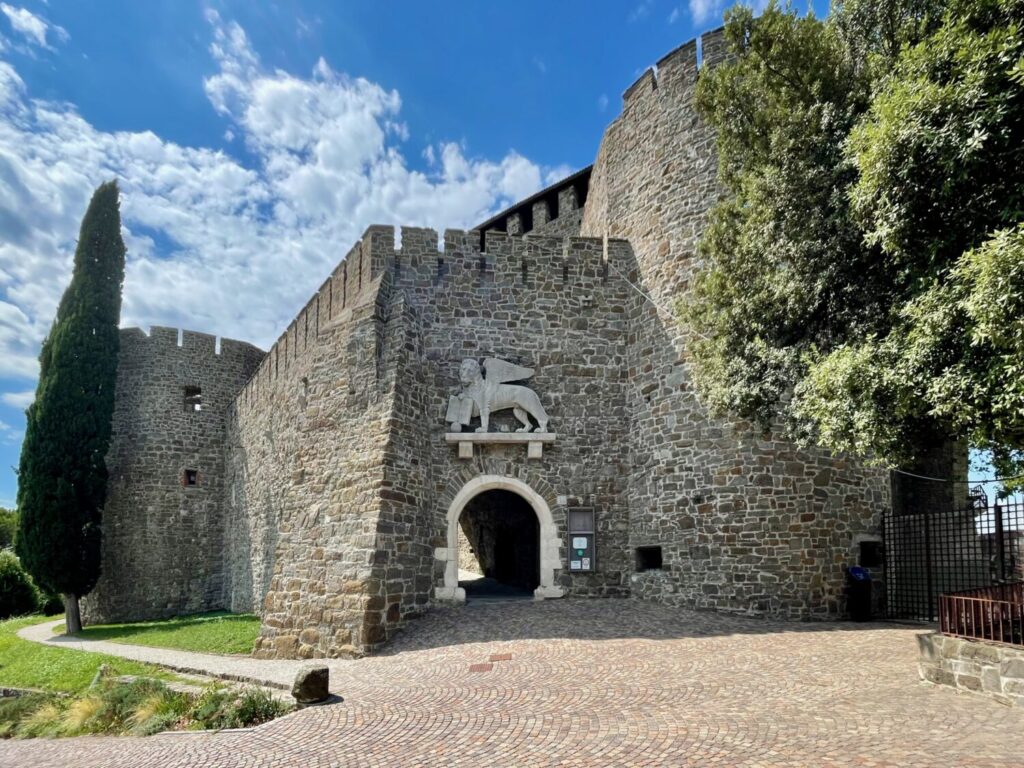
Palazzo Coronini Cronberg in Gorizia: Aristocratic Elegance and Stories of Europe
Palazzo Coronini Cronberg is a historic residence that still reflects the refinement of Gorizia’s aristocracy. Built at the end of the 16th century and transformed in the 18th century, it has preserved its original furnishings, precious objects, and artworks. Among them are the famous “character heads” by the sculptor Franz Xaver Messerschmidt, portraits so strikingly intense and realistic that they almost feel contemporary.
The palace is also tied to wider European history: Charles X of Bourbon, the last king of France, lived here in exile. Today, it houses the Coronini Cronberg Foundation and a museum that feels truly atmospheric. The visit takes you through thirteen fully furnished rooms, kept exactly as they were by the last descendant of the family, Count Guglielmo Coronini Cronberg, who lived here until 1990.
The experience continues outside in a romantic English-style park, featuring statues, fountains, and monumental trees, making it an ideal place for a quiet stroll after exploring the museum. Personally, I’d recommend visiting without children so you can fully appreciate the elegance and atmosphere of this splendid residence.
Palazzo Coronini Cronberg
Viale XX Settembre, 14, 34170 Gorizia, Italy
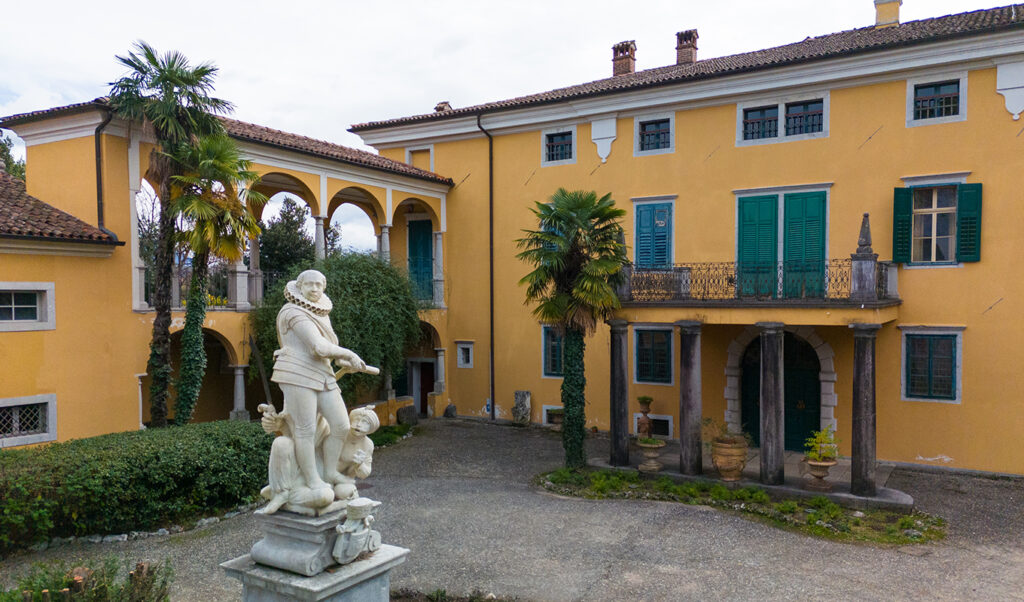
Palazzo Attems Petzenstein: The Rococo Heart of Gorizia
Just a few steps from the centre of Gorizia stands Palazzo Attems Petzenstein, one of the city’s most elegant residences and today home to the Art Gallery of the Provincial Museums of Gorizia. Here, you’ll find almost a hundred works spanning two centuries of art, from the 18th to the 20th century, a must-see if you’re passionate about painting.
Built in 1750 for Count Sigismondo d’Attems, the palace is a refined example of Rococo architecture with interiors full of charm. Among its most striking features are the Ovid’s Metamorphoses Room, painted by Francesco Chiarottini, and the Honour Hall, decorated by Antonio Paroli with the Gods of Olympus and enriched by the monumental Attems Altarpiece by Giambettino Cignaroli.
The gallery’s collection is both rich and varied, ranging from the intense portraits of Giuseppe Tominz, Gorizia’s most renowned painter, to the works of Josef Maria Auchentaller, a Secession artist close to Gustav Klimt. Attems Petzenstein Palace is a place where art, history and beauty come together. Though in my experience, you’ll enjoy it best without children in tow.
Palazzo Attems Petzenstein
Piazza Edmondo de Amicis, 2, 34170 Gorizia, Italy
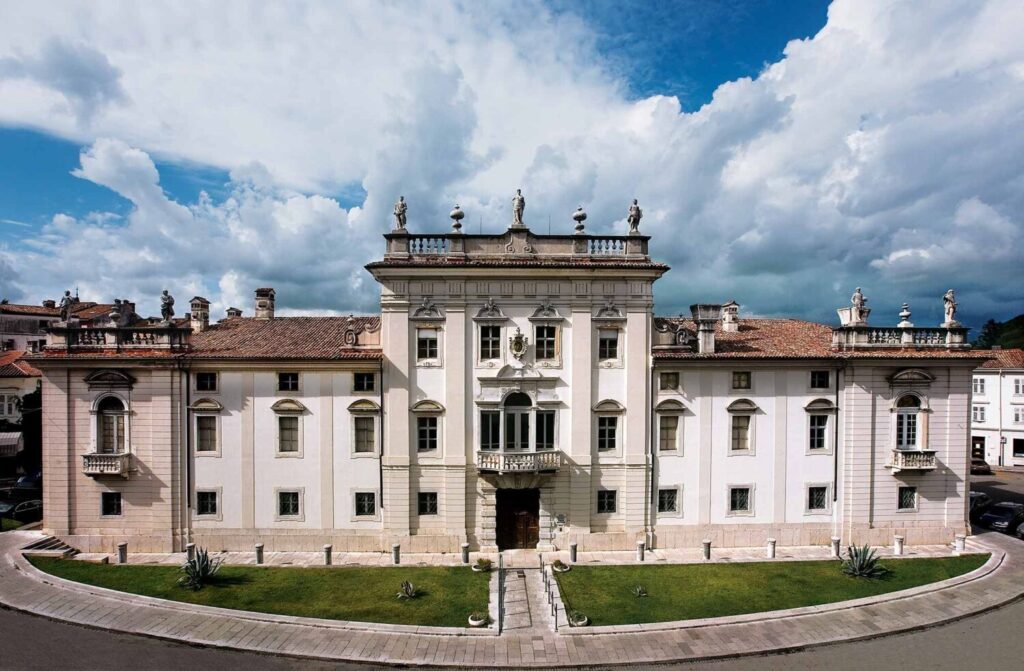
Jewish Gorizia: An Itinerary Through Synagogue, Cemetery and Memory
The Jewish community of Gorizia flourished in the 18th and 19th centuries, leaving a deep mark on the city’s history and cultural identity. The best place to start exploring this heritage is the 18th-century synagogue in the heart of the old town, which today hosts exhibitions and cultural events.
Just outside the centre, the Jewish cemetery of Valdirose is a peaceful and evocative place, where tombstones and monuments tell the story of centuries of community life. As you walk through the city, you’ll also come across commemorative plaques and stumbling stones remembering the Jews deported during the Holocaust, alongside tributes to figures such as the philosopher Carlo Michelstaedter, a Gorizian intellectual whose short life left behind reflections that still resonate today.
Kostanjevica Monastery in Nova Gorica: Bourbon Crypt and Rose Gardens
On the hill overlooking Nova Gorica stands the Kostanjevica Monastery, also known in Italian as Castagnevizza. Founded by Franciscan friars, it is one of the city’s most atmospheric places, where history and spirituality intertwine.
The monastery’s crypt houses the tombs of the last Bourbon kings of France, including Charles X, the last French king to die in exile. Adjacent to the church, you can explore the Škrabec Library, which is home to ancient volumes and precious manuscripts that bear witness to the monastery’s rich heritage.
Outside, the Bourbon rose gardens are among the richest in the world. In spring, the blossoms transform the monastery grounds into an oasis of colours and scents, loved not only by pilgrims but also by botanists and curious travellers alike.
Franciscan Monastery Kostanjevica
Škrabčeva ulica 1, 5001 Nova Gorica, Slovenia
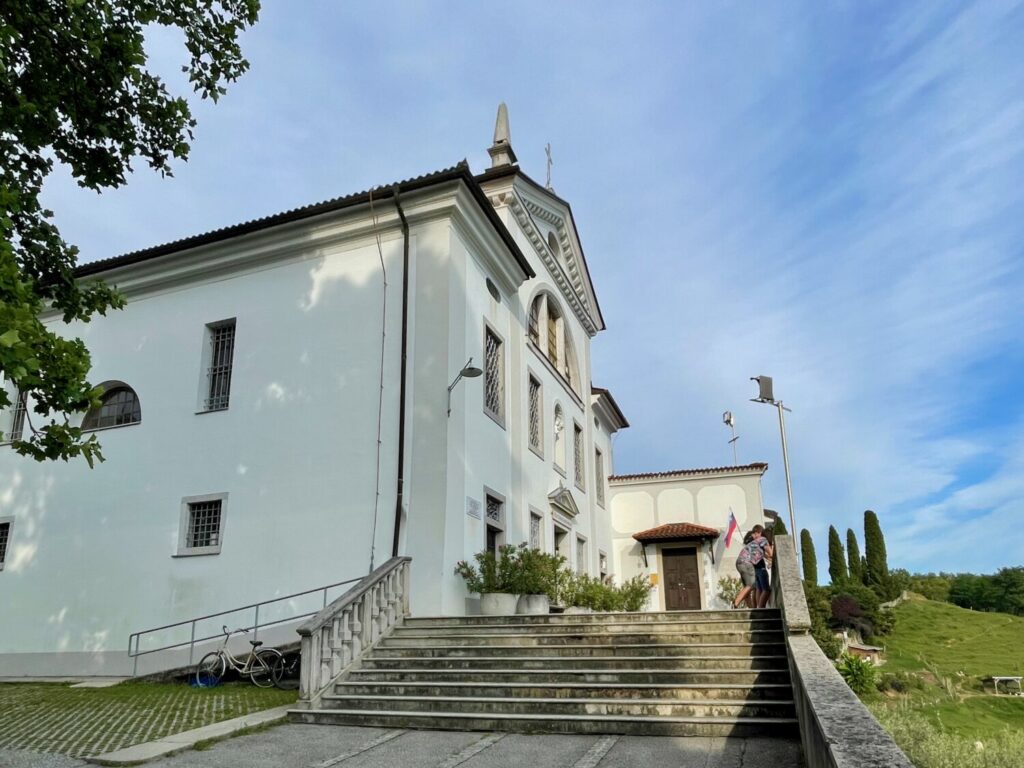
Kromberk Castle: Slovenian Art and History in the Outskirts of Nova Gorica
A few kilometres from Nova Gorica, you can visit Kromberk Castle, an elegant Renaissance residence that today houses the Goriški Muzej, the regional museum of Goriška (Gorizia), which, despite the name, is in Nova Gorica. Set in a panoramic position overlooking the Vipava Valley, it hosts both permanent and temporary exhibitions dedicated to art and local traditions, with collections ranging from the eighteenth century to the present day.
The castle was built in the seventeenth century by the Coronini family, the same family behind Palazzo Coronini Cronberg in Gorizia, as their summer residence, enriched with works of art and furnishings. Over the centuries, it suffered destruction and fires, particularly during the two World Wars, but was rebuilt several times before becoming a museum in 1954.
Today, its four towers and historic rooms recreate the atmosphere of a noble residence. Outside, the gardens and surrounding vineyards provide a scenic backdrop for a peaceful walk. I recommend adding Kromberk Castle to your itinerary if you have time for a short trip beyond Gorizia and Nova Gorica.
Kromberk Castle – Goriški Muzej
Grajska cesta 1, 5000 Nova Gorica, Slovenia
Nature and Landscapes in Gorizia and Nova Gorica: Parks and Isonzo River Views
We travelled to Gorizia and Nova Gorica, mainly fascinated by their border history. Still, once there, we also discovered how green and pleasant these two twin cities are. Beyond their rich cultural and historical heritage, both offer parks, gardens, and natural corners where you can take a break and enjoy truly scenic views.
The urban landscape is closely connected to the emerald waters of the Isonzo River and to places well worth visiting, such as the three bridges of Solkan (Salcano in Italian) or Rafut Park, with its villa surrounded by rare and non-native plants. These experiences reveal a different side of the two cities: quieter, nature-oriented, and perfect to complement a cultural itinerary.
The Three Solkan Bridges: Engineering Marvels Over the Isonzo River in Slovenia
Just outside the centre of Nova Gorica, along the emerald waters of the Isonzo River, you’ll find the three bridges of Solkan (Salcano in Italian). Today, they are part of Slovenia, but in the last century, they were a source of pride for Italian engineering.
The most famous is the stone railway bridge, built in the early 20th century, which still holds the record as the largest stone arch of its kind in the world. Next to it stands the road bridge, which for decades connected the two riverbanks. A third, modern and functional bridge reflects the evolution of transport in the area.
Beyond their historical and architectural value, the bridges of Solkan offer one of the most beautiful viewpoints over the Isonzo River. They are a favourite spot among locals and visitors alike. We reached them on foot with a short, easy walk suitable for everyone.
The area is now also popular for sports and adventure. If you’re after an adrenaline rush, this is the place to try bungee jumping.
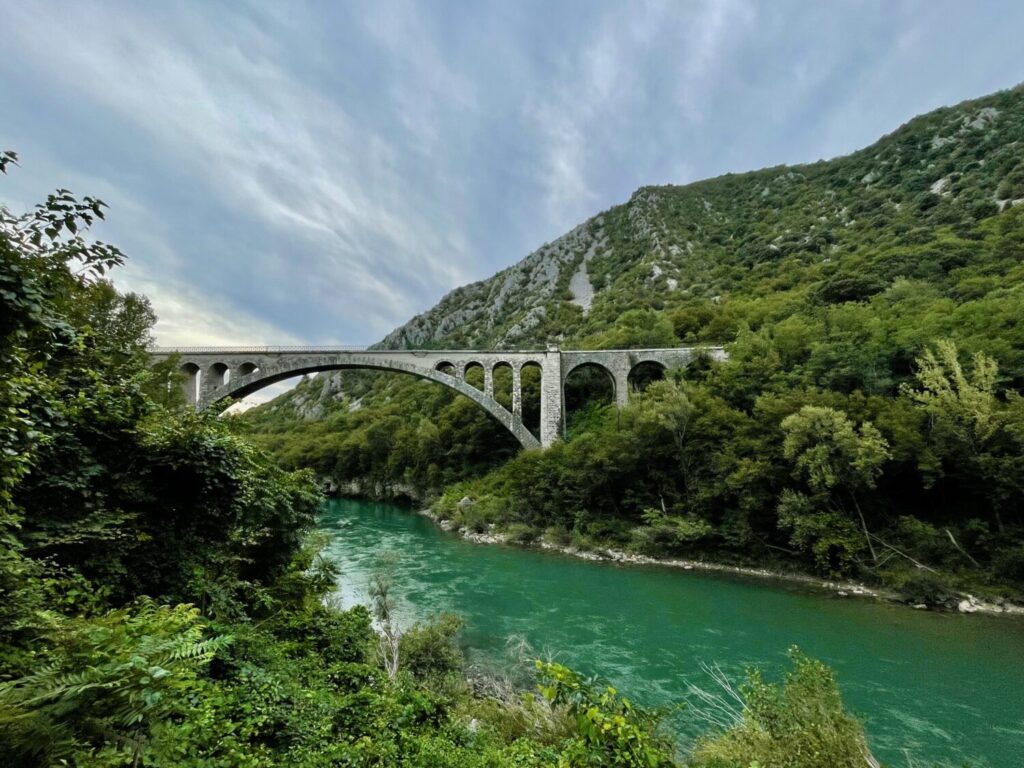
Villa Laščak and Rafut Park: Oriental Charm in Nova Gorica
Rafut Park is one of the most unusual places to visit in Nova Gorica, a green oasis filled with rare plants and monumental trees from around the world. Among its botanical curiosities, you’ll find the oldest cork oak in Slovenia, a living reminder of the park’s international character.
At the heart of the park stands Villa Laščak, designed by Gorizia-born architect Antonio Laščak, who also worked extensively in Egypt. Its eclectic forms and oriental-inspired details reflect the architectural style he developed in Cairo and Alexandria, bringing a touch of the Middle East back to his hometown.
In recent years, the park has benefited from EU-funded restoration projects. Although many of its structures are still awaiting renovation, it remains a fascinating place to stroll between nature and history. You’ll also find contemporary installations here, such as the “Symphonic Forest”, which transforms the sounds of the trees into music.
Rafutski Park
5000 Pristava, Slovenia
How to Get Around Gorizia and Nova Gorica: Practical Travel Tips
One of the most curious experiences when visiting Gorizia and Nova Gorica is being able to cross from one city to the other almost without realising you’re stepping over what was once a hard border dividing two communities.
Today, the two towns are seamlessly connected by squares, pedestrian streets, and cycle paths, making it easy to move around on foot. Distances are so small that, like us, you can comfortably explore both in a day, only using the car to reach the Kostanjevica Monastery perched on the hill above Nova Gorica.
If walking isn’t your thing, or if you have mobility issues, you can hop on the cross-border urban bus that runs between Gorizia and Nova Gorica. Unfortunately, the website is only in Italian; there is no English version at the time of writing.
Driving is equally easy. Traffic is light, and parking is plentiful and free on both sides of the border. Just keep in mind that names on signs change depending on whether you’re in Italy or Slovenia. Solkan becomes Salcano, Piazza Transalpina is also Trg Evrope, and the same applies to many other landmarks.
How to Reach Gorizia and Nova Gorica: By Car, Train, Bus or Plane
If you’re travelling by car, Gorizia and Nova Gorica are easy to reach from both the Italian and Slovenian sides. I drove there from Slovenia after visiting the Park of Military History in Pivka. Thanks to their strategic location on the border, you can arrive via motorway or secondary roads, whichever side you’re coming from.
By train, for the Italian side, regional trains and a few long-distance services stop at Gorizia Centrale station. If you’re travelling from Italian cities such as Milan or Bologna, you’ll usually need to change trains in Venezia Mestre or Monfalcone stations.
On the Slovenian side, Nova Gorica is not so well connected to the national rail network. Apart from a few tourist or local services, the line from Ljubljana often involves changes and is partly replaced by buses.
Buses are a practical option, with direct connections to nearby cities and airports on both sides of the border. There are also international lines that stop in Gorizia and Nova Gorica. If you’re travelling from Ljubljana, it’s usually more convenient to take a direct bus or check mixed travel options on platforms like Omio.
The nearest airport is Trieste – Friuli Venezia Giulia (TRS, Ronchi dei Legionari), about 20 km from Gorizia, with quick bus and train connections. Alternatively, you can fly into Ljubljana Jože Pučnik Airport (LJU), approximately 130 km from Nova Gorica. Although it’s a bit further away, it’s a good option if you also plan to visit Ljubljana during your trip.
Where to Stay in Gorizia and Nova Gorica: Best Accommodation Between the Twin Border Cities
For this trip, I planned everything at the very last minute, so I had to compromise on accommodation. I booked a private room with a bathroom in Nova Gorica, in the residential district of Solkan. Many of my readers love staying in apartments, but I prefer hotels, as they usually guarantee better standards and fewer surprises.
Solkan may sound familiar due to its famous bridges, but the neighbourhood isn’t actually that close to them; we had to drive there. From Solkan, you can walk to both Gorizia and Nova Gorica if you don’t mind longer walks. However, the location is still a bit off-centre compared to Piazza Transalpina/Trg Evrope.
If you want a comfortable stay right in the heart of Gorizia, I’d recommend the Grand Hotel Entourage, housed in a 16th-century noble residence close to Gorizia Castle. If you’re driving and prefer a quiet setting outside Nova Gorica, the DAM Boutique Hotel & Restaurant is a good choice, with a seasonal pool, garden, and terrace.
For something completely different, in Nova Gorica you’ll find the Perla Casino & Hotel, part of Europe’s largest casino. I wouldn’t recommend staying there with children. Still, it’s perfect if you travel alone or with other adults and are after a unique experience with a spa, indoor pool, and the lively atmosphere of a casino resort.
Now that you know everything about the twin cities of Gorizia and Nova Gorica, feel free to share in the comments if their border history or cultural vibe inspired you to plan a trip.
